What is sampling?
The information from the transducer on the EK80 system is a continuous flow of analogue data. In signal processing, sampling is the reduction of this continuous signal to a discrete signal.
A common example is exactly what we do in the EK80 system. We convert a sound wave (which is an analogue continuous-time signal) to a sequence of samples (which is a discrete-time signal).
A discrete (or discrete-time) signal is a sequence of data capsules. This typically a signal that has been sampled from a
continuous-time signal.
Unlike a continuous signal, a discrete signal is not a function of a time argument, but a sequence of quantities, a function
over a domain of discrete integers. Each value in the sequence is called a sample.

In this coordinate system, the Y-axis is voltage (or “volume”) and the X-axis is time.
| A | This is a continuous flow of data, an analogue signal, for example an echo. |
| B | This line identifies the samples that the system is extracting from the analogue signal. Each sample is identified with the time it was taken. It will contain the value of the analogue signal at that time. |
| C | The distance between each vertical line is the time between each sample. This time is identified as the sampling rate. |
Using this technique, the analogue signal is converted to a stream of discrete signals.